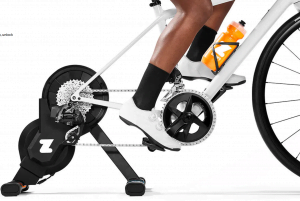 the Zwift Hub
the Zwift Hub
Zwift has finally got into the smart trainer game. It’s not an indoor bike but rather something you put your existing bike onto.
TL;DR – It lacks a carry-handle, includes a cassette and could be more accurate. For a $/Eu500 price point (£450), they have priced their all-singing, all-dancing smart trainer very nicely indeed. It’s a game-changer in the sense that it has already forced Wahoo to lower prices. Everyone else will follow.
Trainer Deals on Wahoo, Tacx and more at Wiggle…up to 46% off means that new models are coming very soon.
Zwift Hub Thoughts
Zwift faced a choice: an expensive, low sales volume, high margin smart bike made in-house vs a cheap, highish volume subcontracted offering.
They sensibly chose the latter. Although it’s not a strategy without risks.
The Zwift Hub is manufactured by JetBlack but $250/£200 cheaper. It clearly signals what Zwift think the entry-level pricing needs to be for decent hardware to support their app. Perhaps higher spec Zwift trainers will follow if this turns out to be a success. Perhaps Zwift will buy Saris…someone is!
Hub is somewhat similarly specified to the Kickr Core, except the Core has a carry handle and is a tad more accurate. Kickr Core also doesn’t come with a cassette as well as a higher price tag, now at £599/Eu-$700
If you’re not so sure about your commitment to indoor training this Winter there are even cheaper ways to start it but this IS a sensible starting point if you are looking to buy a new smart trainer. Personally I would go for the next price tier up and the extra specifications it brings but that next price tier is almost double the price of this and you really then have to question value-for-money.
Zwift Hub Specifications
| Zwift Hub | Specifications |
| Size and Weight | |
| Length: | 49.7 cm / 19.5 in |
| Width: | 61.2 cm / 24 in |
| Height: | 46.1 cm / 18.1 in |
| Weight: | 16.5 kg / 36.4lb |
| Performance and Data | |
| Power accuracy: | +/- 2.5% |
| Max wattage: | 1800W |
| Max gradient simulation: | 16% |
| Flywheel weight: | 4.7 kg / 10.3lbs |
| Metrics: | Power, cadence, speed, & distance |
| Connectivity | |
| Transmits measured data using both Bluetooth FTMS and Ant+ FEC | |
| Accepts control data using either Bluetooth FTMS or ANT+ FE-C | |
| Can connect to an ANT+ heart rate monitor and relay data via Bluetooth | |
| The LED status light shows ANT+ and Bluetooth connection status | |
| Over-the-air Firmware updates via Bluetooth using Zwift Companion App | |
| Compatibility | |
| Wheel Sizes: | Compatible with 650c, 700c, 24″, 26″, 27.5″, 29″, Road and MTB wheels |
| Axles: | Compatible with 130 mm and 135 mm quick release, 12×142 mm and 12×148 mm thru axles |
| Freehub body: | Hyperglide |
| Additional Specs | |
| Maximum rider weight: | 120 kg / 264.5 lb |
| Sound | 52 db at 250 watts |
| Operating temperatures: | -10 C to +35 C (14 F to 95 F) |
| Power requirements: | 100-240 V, 1.5 A, 50 Hz-60 Hz |
| Preinstalled cassette gear ratios | |
| 12 speed option: | 11-30 tooth |
| 8, 9, 10 & 11 speed options: | 11-28 tooth |
 the Zwift Hub
the Zwift Hub

Wait what, didn’t say they were getting out of the hardware business a few months ago and fired most of the employees of that branch ?!
yep.